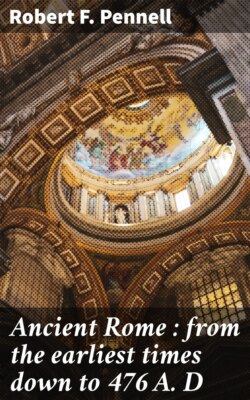Читать книгу Ancient Rome : from the earliest times down to 476 A. D - Robert F. Pennell - Страница 8
На сайте Литреса книга снята с продажи.
CHAPTER III. THE ROMANS AND THEIR EARLY GOVERNMENT.
ОглавлениеTable of Contents
We have learned the probable origin of the LATINS; how they settled in Latium, and founded numerous towns. We shall now examine more particularly that one of the Latin towns which was destined to outstrip all her sisters in prosperity and power.
Fourteen miles from the mouth of the Tiber, the monotonous level of the plain through which the river flows is broken by a cluster of hills (Footnote: The seven hills of historic Rome were the Aventine, Capitoline, Coelian, Esquiline (the highest, 218 feet), Palatine, Quirínal, and Viminal. The Janiculum was on the other side of the Tiber, and was held by the early Romans as a stronghold against the Etruscans. It was connected with Rome by a wooden bridge (Pons Sublicius).) rising to a considerable height, around one of which, the PALATINE, first settled a tribe of Latins called RAMNES—a name gradually changed to ROMANS.
When this settlement was formed is not known. Tradition says in 753. It may have been much earlier. These first settlers of Rome were possibly a colony from Alba. In the early stages of their history they united themselves with a Sabine colony that had settled north of them on the QUIRÍNAL HILL. The name of TITIES was given to this new tribe. A third tribe, named LUCERES, composed, possibly, of conquered Latins, was afterwards added and settled upon the COELIAN HILL. All early communities, to which the Romans were no exception, were composed of several groups of FAMILIES. The Romans called these groups GENTES, and a single group was called a GENS. All the members of a gens were descended from a common ancestor, after whom the gens received its name.
The head of each family was called PATER-FAMILIAS, and he had absolute authority (Footnote: Called patria potestas.) over his household, even in the matter of life and death.
The Roman government at first was conducted by these Fathers of the families, with a KING, elected from their own number, and holding office for life. His duties were to command the army, to perform certain sacrifices (as high priest), and to preside over the assembly of the Fathers of the families, which was called the SENATE, i.e. an assembly of old men (Senex).
This body was probably originally composed of all the Fathers of the families, but in historical times it was limited to THREE HUNDRED members, holding life office, and appointed during the regal period by the king. Later the appointment was made by the Consuls, still later by the Censors, and for nearly one hundred years before Christ all persons who had held certain offices were thereby vested with the right of seats in the Senate. Hence, during this later period, the number of Senators was greatly in excess of three hundred. The Senators, when addressed, were called PATRES, or "Fathers," for they were Fathers of the families.
The Romans, as we saw above, were divided at first into three tribes, Ramnes, Tities, and Luceres Each tribe was subdivided into ten districts called CURIAE, and each curia into ten clans called GENTES (3 tribes, 30 curiae, and 300 gentes). Every Roman citizen, therefore, belonged to a particular family, at the head of which was a pater-familias; every family belonged to a particular gens, named after a common ancestor; every gens belonged to a particular curia; and every curia to a particular tribe.
We have learned that in the early government of Rome there was a king, and a senate that advised the king. Besides this, there was an assembly composed of all Roman citizens who could bear arms. (Footnote: We must remember that at this time no one was a Roman citizen who did not belong to some family. All other residents were either slaves or had no political rights, i.e. had no voice in the government.) This assembly of Roman citizens met, from time to time, in an enclosed space called the COMITIUM, which means a place of gathering or coming together. This was between the Palatine and Quirínal hills near the FORUM, or market-place. This assembly itself was called the COMITIA CURIÁTA, i.e. an assembly composed of the 30 curiae. This body alone had the power of changing the existing laws; of declaring war or peace; and of confirming the election of kings made by the senate. The voting in this assembly was taken by each curia, and the majority of the curiae decided any question.
